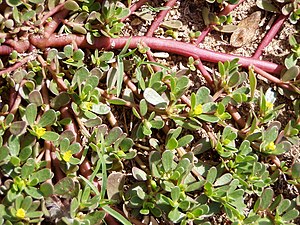 Image via WikipediaPurslane:
Image via WikipediaPurslane:Purslane (Portulaca oleracea, P. sativa) is a member of the Portulacaceae Family and also known as wild portulaca and verdolaga. It is thought that the genus name, Portulaca is from the Latin porto and laca meaning “milk carrier” in reference to its milky sap. The species name, oleracea, is Latin and means “potherb.”And you thought that was a lowly weed in your garden. Grows like crazy in mine - hurray! Perfect - raw - in a salad. Eating like Gandhi and Thoreau - an added badge of honor.
Native to Persia, Africa and India, purslane was introduced into Europe by Arabs in the 15th century as a salad herb, and has spread into the United States and Central and South America. It is found in gardens and vacant area in damp to dry soil.
Purslane is an annual, low growing fleshy herb, up to eight inches tall with prostrate reddish stems. The leaves are succulent, smooth, paddle shaped and about one-half to one-inch-long and arranged alternately. Tiny yellow flowers about 3/16 of an inch open when the sun shines, followed by tiny dark colored seeds.
Purslane leaves are considered alterative, antiscorbutic (preventing scurvy), antiseptic, diuretic, hypotensive, mucilaginous, nutritive and refrigerant (Helps keep you cool).
Purslane has been used throughout history in treatment of cardiac weakness, dry cough, diarrhea, dysentery, fever, gingivitis, and high cholesterol, hypertension, sore throat and urinary tract infections. Topically purslane has been used as a poultice for bee stings, boils, burns, and hemorrhoids.
Purslane is reported to have been one of Mahatma Gandhi’s favorite foods and also consumed by Thoreau while residing at Walden Pond. It is pleasant, cool, and moist, with a sour flavor that can be enjoyed raw or cooked. Use purslanes in salads, pickles, stir fry dishes and soups as a cooling summer food. Bake purslane shoots with breadcrumbs as a casserole. It can be used in place of okra in recipes.
Purslane is used in Creole cooking and in the mideastern salad, fattoush. The dried seeds can be ground and added to flour. I’ve noticed our local farmer’s market selling this fine herb to introduce people to purslane’s vegetable potential.
One hundred grams of purslane contains about 2,500 IU beta-carotene, 103 mg. calcium and 25 mg vitamin C. In 1986, purslane was discovered to be the richest plant source of omega-3 fatty acids, which helps reduce the risk of heart disease and can help lower blood pressure and cholesterol levels.

No comments:
Post a Comment